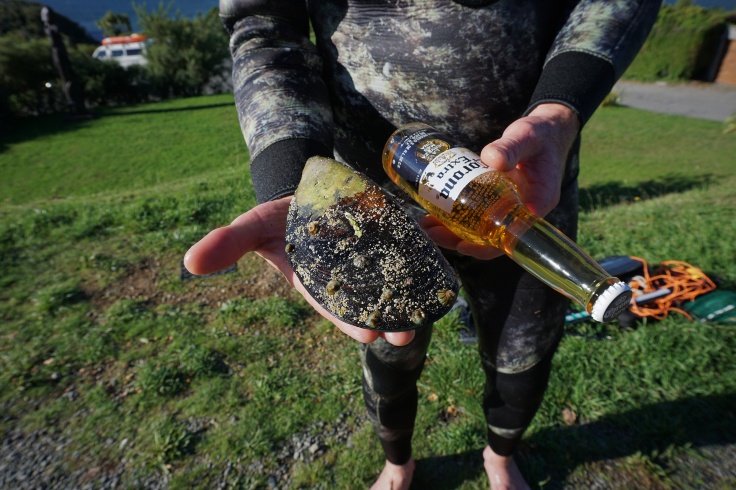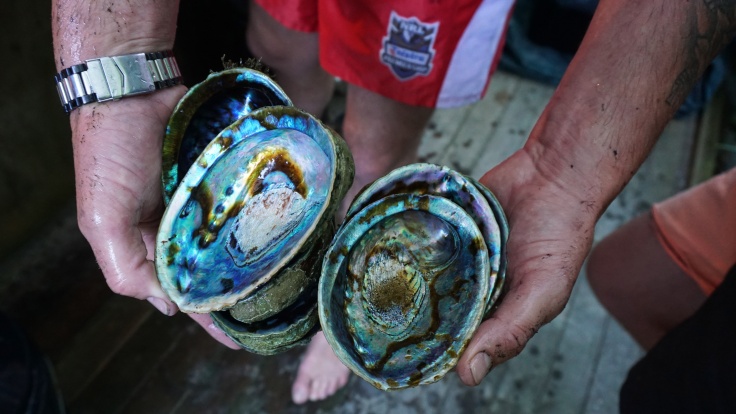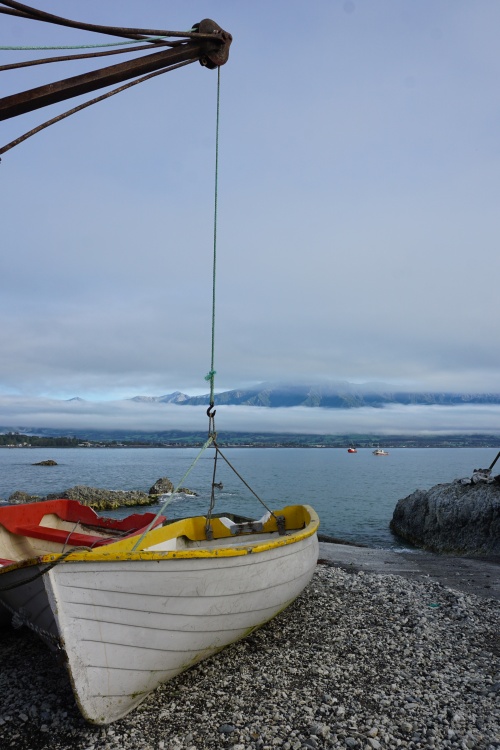Sometimes I don’t mind smelling like fish. Especially when it means I’m about to have a delicious meal. Wrist-deep in flour and bread crumbs, I was working for this dinner. “You have to hold the fillet like this—dip it in the egg first, then the flour!” directed Riley, my five-year-old seafood instructor, his Kiwi accent filled with helium at such an urgent octave. “Yes, that’s better. Almost done!” Fifteen minutes and fifty fillets later we had a pile of battered fish fit for our New Year’s Eve feast.
Despite having already been in New Zealand for Christmas this year, it still surprised me that New Year’s had brought with it warm winds and summer BBQs, not the chance of snow and hot cocoa I was accustomed to from January in the States. Summer graces New Zealand from December through February—a time when most Kiwis take a few weeks off with family to enjoy the holidays and temperate weather. Many head to “baches” (beach homes under a day’s drive away) to swim, sip and snack away the day. Although, no sun bathing here; the sun is strong enough to reach lobster level in just 20 minutes. The government advertised slogan is “slip, slop, slap”—“slip” into that shirt, “slop” on some sunscreen, and “slap” on your hat. At least New Zealand has embraced Baz Luhrmann’s advice.
In more remote reaches like the North Island’s East Cape, where I got my fish dressing lesson, you’ll find strings of sparsely populated beaches, and with them plentiful seafood. The chances of finding green lipped mussels the size of your shoe here are favorable odds. In ten days at our friends’ bayside bach, I felt I’d materialized into that scene in Forest Gump (substitute Southern drawl for Kiwi slang of course)—we devoured beer battered and bread crumbed fish, fried fish, fish on a bun with slaw, fried mussels, mussels sizzling in the half shell over hot charcoal, steamed crayfish, crayfish with butter, paua (NZ’s abalone) sautéed with butter and garlic, paua in cream sauce, paua on that slaw bun… the list goes on.

Seven years and several trips to New Zealand later, somehow I’m only finally understanding how strongly the sea and its bounty permeate Kiwi culture.
In fact, this nation’s connection to the sea is legendary. The Māori, New Zealand’s indigenous population, tell of Maui the demigod and great fisherman who pulled New Zealand (Aoteroa) from the sea. One day he and his brothers sat fishing when his line went taught as a blade. Against extreme force, Maui fought to pull a giant fish from the depths. His brothers squabbled over the prize, tearing grooves and peaks into the fish’s flesh. In so doing they created the mountains and valleys of New Zealand—Maui’s fish would become the North Island of Aoteroa and their waka (canoe), the South. Stewart Island (Rakiura), the triangular island at the base of NZ served as the anchor to help haul Aoteroa from the waves.
Today, New Zealand harvests from one of the largest fishing zones in the world and seafood ranks among the nation’s highest export earners (both sitting solidly in their respective top 10). Recreational fishing endures as a common pastime—Kiwis boast one of the globe’s highest boats per capita. Even New Zealand’s largest city of Auckland, known for its skyscrapers not sea dwellers, bears more boats per person than any other city in the world. It’s not surprising that Kiwis have an affinity for the ocean, living in a country where you stand at most only 80 miles inland from the water on a coastline eroding by nearly a meter each year. Sandwiched between the Tropic’s rain-bearing winds and Antarctic polar blasts, Aoeteroa inspires locals with a much-deserved reverence for Mother Nature, her ocean and its edible gifts.
And yet, most visitors miss this aspect of “Kiwiana”—they come to see their favorite view from The Lord of the Rings, the Instagram-worthy alpine lakes, or the chance to glimpse a Hobbit (or sheep, more likely) running across glowing green hillsides. Scarfing the classic fish ’n’ chips after one too many pints ends up masquerading as their only taste of New Zealand “seafood.” While undeniably delicious, this doesn’t do justice to NZ cuisine. They have more going for them here than fried pub food handed down from the Brits. My advice—do as the Kiwis do… leave the Hobbits to their hills, and go find some summertime Kaimoana (if you skipped the title, that means “seafood”).
Surf clams
Perhaps the easiest catch, NZ has several varieties including Pipis, Tuatuas, and Cockles. Shoot for maximum an hour on either side of low tide, zip up those nifty traveling pants, and wade in calf deep off of the beach.
Bucket in hand, do the “Tuatua Twist,” zigzagging your feet a few inches into the sand until your toes uncover the prize. Tip: look for submerged sections of sandy beach floor already littered with open shells (the signs that birds have already found a clam bed). The best places for digging: the East Coast’s sandy beaches, bays or estuaries with little swell. Summertime yields the most pleasant temperatures, but New Zealand shellfish can be gathered year-round.
Keep the clams overnight in a bucket of salt water; they’ll continue to filter the water, spitting out any remaining sand. Like most shellfish they should be kept alive until eaten. Place in a stove top pot with a few inches of salt water to steam open in seconds. Chuck any duds that stay shut. Once shucked they can be added to a creamy pasta or chowder, or chopped and folded into batter a la fritter—a New Zealand summer specialty.
Recipe favorites: Pipi fritters | Tuatua fritters | Seafood pasta | Pipi chowder
Mussels
Native green lipped mussels remain one of the cheapest forms of protein in NZ supermarkets at about $5 NZD/kg (that’s less than the beloved kumara sweet potato). Driving along the coast you may spot sustainable mussel farms floating on checkerboards of rope and buoys.
Mussels thrive in a mix of fresh and salt water with some current activity so search for submerged rocks where a stream or estuary meets the ocean. Gather at low tide to ensure only healthy mussels living below the water line make it into your bucket. Give the little guys a chance and stick to palm-sized mussels if you can. Green lips take over a year to mature and reach a whopping 9-12 cm (3.5-5 inches), so skip the smaller black mussels you’ll see on shore—these smaller relatives are edible but not worth the effort. You may also see oysters on your search, but you’ll need a special knife to pry them from the rocks, where as our mussel friends can be gathered by hand.

Steam them open and shuck, including the feathery “beard” and circular “chewing gum” that should stick to the shell. Leave them in the half shell and grill open faced on a BBQ. I recommend filling the shell with a mixture of green thai curry paste and coconut milk, parmesan with diced tomatoes and basil, or the simple beauty: garlic butter. Fully shelled, you can beer batter and fry or even eat mussels raw. The vibrant orange mussels are female and the white are male, but both are protein-rich, laden with Omega-3s and equally delicious. However you eat them, don’t forget to pair with a New Zealand sauvignon blanc.

The best places to look—moderately exposed coasts on the warmer North Island, or the South’s Marlborough Sounds. Do take note of daily catch limits for your area, which average 50 mussels per person.
If you fancy someone else’s cooking, try the Mussel Kitchen near Coromandel Peninsula. Aptly named, mussels are the star here from battered baskets to steaming pots with craft beer and outdoor picnic table seating. But beware—the portions are deceivingly large. Down south Havelock is the mussel capital of New Zealand with an annual seafood festival around St. Patty’s Day in mid-March. The Mussel Inn tavern near Takaka also has an unbeatable local pub atmosphere, open fireplace, brews and mussel chowder.
Recipe favorites: 5 grilled half shell flavors | Thai style | Beer batter fried mussels
Fishing
Even the smallest town in New Zealand has three things—a pub, a post office, and a “dairy” convenience store that doubles as a bait shop. You can pick up cheap rods and all the fixings throughout the country—just ask around in any coastal town. You’ll see folks surfcasting past the waves off most beaches or angling from a rocky point.

In larger port towns, especially the North’s Bay of Islands and Bay of Plenty, or Nelson and Kaikoura in the South, you can charter fishing day trips. Big game fishing is common in the far Northland. Walk along the pier in Russel at summertime dusk and you’ll see boats queuing up to weigh in 350 pound (160 kg) Blue Marlin for the daily prize. Summer also marks the heat of river fishing season with abundant trout fly fishing especially in the top of the South Island. As always, take note of local fishing sizes and daily limits.
Favorite recipes: Homemade beer battered fish and chips | Ginger beer battered
Free diving
For the amphibious among us, New Zealand free diving surfaces delicacies like paua (black or yellow abalone), found on rocky coastlines below the tide line at one to 15 meters deep. Scoop these mollusks off the rocky floor freehand or using a flat tipped tool like your average table knife, but be quick. You’ll have one chance—knock their shells, missing a clean snatch, and they reflexively anchor down like superglue. Be sure to size them up before plucking, as there is a strict minimum size limit of 125mm and any forcibly removed paua will die, unable to recover their footing.

An NZ icon, paua are often better known for their mosaic, rainbow shells fashioned into jewelry and carvings, but they are surprisingly good eating. Even if they do look like escargot’s sea monster cousin, they’re worth a try (just close your eyes and think of eating a meatier mushroom). Boil directly in salt water for about three minutes to soften the meat and make it easier to shuck. Remove the meat and do away with the rest; further tenderize if desired, slice thinly, and sauté extravagantly in the magic that is garlic butter. Paua prefer the cooler water temperatures south of East Cape latitude or in the South Island but can be found throughout NZ.
For those who really want to taste the sea, Kina (sea urchin) can be gathered around the coast at the same depths as paua. These spiny black baseballs thrive between rocks, often hidden in seaweed just below low tide. As sushi fanatics may know, these little beasts should be eaten immediately for the best flavor. Use strong scissors to cut a larger opening in hold at the bottom of the shell and scoop out the orange roe. Enjoy raw or as a garnish similar to caviar. Two ideas I’ve read but have yet to try: kina with margarita shooters (apparently salt goes well with salt?), and a “man’s breakfast” of smoked kina with eggs, bacon, black pudding and a beer.

Crayfish, fondly known as “crays,” or as the B-52’s would say: Rock Lobstaaaahhhh, can also be found in the rocky crevasses off NZ’s jagged coastline. A bit more wiley and elusive, be sure to wear gloves and snatch behind the horns. The best place to find them on your restaurant plate—the town of Kaikoura, which literally means “eat crayfish” in Māori.
Favorite recipes: Fried kina with egg & creamed mushrooms | Kina omelette with lemon
Spearfishing
Wrasse fish tacos, butterfish curry, fish in wonton soup, home-fried fish with chips, porae and mash, snapper and sesame coleslaw, fish as sashimi… it’s Bubba Gump the sequel. My boyfriend and travel partner dove headfirst into a spearfishing obsession this year and it fed us for the entire summer. “I’m off to nature’s free supermarket!!” he’d shout before scrambling off with fins and mask in hand, looking for his next “secret spot.” I can’t complain, Butterfish (also called Greenbone), a herbivore who feeds on coastal seaweed, remains some of the best fish I’ve ever tasted. Soft, flaky, it melts in your mouth like… you guessed it—butter.

“Spearfishing is easier to get into than I thought. It’s a more selective way to fish—you can see what you catch,” Gabe tells me. The New Zealand made brand Wetties make top quality spearguns and sell the full range of dive gear from their HQ located just north of Auckland. You can also find their products in Kaikoura’s Hunting & Fishing branch—just ask the exceedingly knowledgable owner, Anton.

New Zealanders live on islands home to some of the most untamable land on the planet, with highly rural or remote areas dominating 53% of the nation’s land mass. It seems these impassable wild places and the vast ocean that surround them have bestowed a subconscious and enduring appreciation for nature that’s sometimes lost in consumer-driven, landlocked parts of the world. An appreciation for the ocean’s abundance, for taking only what you need and throwing back the rest, and for the joy of homemade, home-caught meals shared with friends and family. So before you buy another pound of pre-packaged sausages to cook in your campervan as you tiki tour the country, why not look up the best tides for fishing at nature’s free supermarket. Overlook Kaimoana when traveling in New Zealand and you won’t taste true Kiwiana (that simply means: as “kiwi as” it gets).
Bon Appétit,
xo SJ
How-to
When to go: The main fishing season runs from October to April, but go between November and March for the best summer weather.
How to get there: Air New Zealand offers non-stop flights from Vancouver, San Francisco, Los Angeles, and other worldwide destinations, along with the best inflight safety videos you’ve ever seen. Traveling by camper van is one of the best and easiest ways to see the country—try Maui, Britz or Apollo for mid-range or Juicy Camper for budget rentals. You can also book via Share-a-camper for an Airbnb-type rental. Certified self-contained vehicles (meaning they include water & waste containment) can travel off the beaten path and most caravans come with stovetops which allow you to make your own affordable meals. Why settle for pasta and instant meals when you’re always within miles from nature’s free supermarket.
Fishing Equipment: You can make a one-stop shop at any Hunting & Fishing upon arrival (they are a countrywide chain), or ask locals or the iSite visitor center for nearby fishing stores.
Seafood Safety: All shellfish should be kept as fresh as possible in salt water until eaten. Discard any rotten shellfish that do not open after a few minutes upon steaming. Watch out for signs indicating any polluted areas where seafood should be avoided. Read more about seafood safety and collecting practices here.
Fishing Limits: Strict quotas ensure sustainability of New Zealand seafood. When gathering or catching any type, always refer to these local fishing limits. High fines result from any infractions (locals or visitors alike).
More resources
- For the latest NZ Fishing news: http://www.nzfishingworld.co.nz/
- Tide reports for the best times to go: http://www.tides4fishing.com/nz
- NZ weather changes rapidly; check for the latest update: http://www.metservice.com/national/home
- Find Kiwi seafood recipes to try: http://www.bite.co.nz/search-results/seafood
- Note fishing limits & any pollution warnings: https://www.mpi.govt.nz/travel-and-recreation/fishing/fishing-rules/








Wonderful! : )
LikeLike
My mouth continues to water.
LikeLike
I’m not only Curious……my mouth is watering with desire for New Zealand mussels.
LikeLike